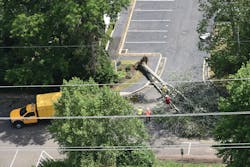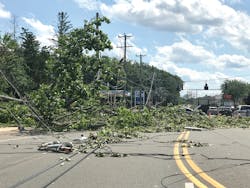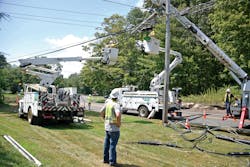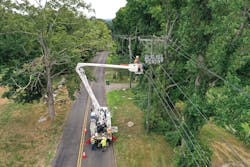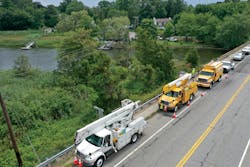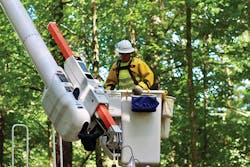Linemen Rebuild Grid Following Tropical Storm
Tropical Storm Isaias packed a punch in Connecticut, inflicting widespread and severe damage greater than both Super Storm Sandy and Tropical Storm Irene. All 149 communities served by Eversource in Connecticut sustained some degree of damage to their electrical system. In some cases, the damage was so severe that parts of the grid had to be rebuilt.
After the storm roared through the state, Eversource used drones to quickly assess damage in hard-to-reach areas where 2,000 roads were blocked. The line crews then responded to 2,500 broken poles, 1,100 damaged transformers, 10,000 trees and more than 500 miles of downed or damaged lines.
The windward side of Tropical Storm Isaias tracked over Connecticut, which brought the heaviest winds and damage of the three storms. The tracks of Storms Sandy and Irene had heavier rains, resulting in more flooding. Despite the high level of damage to its system, Eversource was able to restore Connecticut customers in record time. While Tropical Storm Isaias resulted in more damage locations than Sandy and Irene, the line crews restored power following Isaias in eight days, Sandy in 11 days and Irene in 12 days.
“We achieved our initial goal — to have 90% of our customers in power — ahead of schedule,” said President of Regional Electric Operations Craig Hallstrom. ‘The thousands of crews that worked tirelessly on this massive restoration mounted a heroic effort and did a tremendous job under difficult conditions — working in the heat while abiding by strict social distancing and pandemic safety protocols — all while restoring customers in record time.”
Being Prepared
To respond quickly to the storm damage and to outages, Eversource’s Incident Management Team activated its Emergency Response Plan well in advance of the event. The team was thoroughly prepared for a major event with greater impact than models predicted.
Three conditions combined to intensify the destructive force of the storm beyond expectations. First of all, the westerly track of the storm toward the New York border left Connecticut on the east side of the storm where the higher impact winds occurred. This condition was forecasted on Monday, Aug. 3, but would not have unexpectedly elevated the destructive force of the event on its own.
Secondly, as the storm was dissipating, it spewed higher sustained winds and wind gusts than anticipated across a widespread area, with localized pockets of powerful winds that caused severe impact to trees and vegetation surrounding the overhead system.
Finally, long-running drought conditions occurred across Connecticut in 2015-2017, undermining the integrity of tree root systems and making trees more vulnerable to insect pests and diseases. The higher-than forecasted sustained wind speeds in local circulations caused thousands of mature trees with full leaf canopies to topple on to overhead electric infrastructure.
Focus on Vegetation Management
A perfect storm of weather conditions and insect infestation over the last several years devastated Eversource’s trees across Connecticut. The state experienced significant winds in a short period during a season when those trees are in full leaf canopy, which resulted in extensive damage.
Mature trees weakened by drought, disease and insect infestation brought down wires and poles in every corner of the state, significantly damaging the electric system to the point that portions of the grid had to be rebuilt.
To address the damage arborists dispatched more than 750 tree personnel, some were paired up with electric line crews to handle complex trouble spots, other tree crews were dispatched to clear the way in advance of line crews to help speed the restoration effort. Arborists dispatched these crews based on information drawn from the energy company’s Outage Management System.
Expediting Restoration
Peak outages as a result of Tropical Storm Isaias occurred at 3:30 p.m. on Wednesday, Aug. 5, 2020, and impacted 632,632 customers. The southwest corner of the state and the Hartford region were the hardest-hit areas, yet damage from this storm was experienced in each town in Eversource’s service territory.
As the line crews worked to replace damaged poles and pole-top equipment like cross arms and hardware, they rebuilt the infrastructure to the company’s most updated standards. For example, they replaced broken wood crossarms with stronger, composite cross arms.
To speed up the restoration of power, Eversource deployed decentralized satellite command centers to six locations across the state, where experienced operations leaders drove and controlled the restoration process in their area. These satellite command centers put the crews and materials closer to the areas where they were needed most, providing greater flexibility to more quickly deploy the massive crew resources. This localized approach also reduced communications and materials bottlenecks and provided more efficient deployment of crews to expedite the progress.
The new mobile command centers give the operations personnel the same capabilities they would have sitting in an Eversource facility. The mobile command center allows for full integration with the company’s suite of restoration tools, such as the Outage Management System, Vehicle Locating applications (AVLS), and Microsoft applications such as Teams, etc. It allows the company to push the restoration activities out into the field to be closer to the work with no degradation of capability.
Staying Safe
Eversource has been operating under its COVID-19 pandemic plan since Mid-March, and those guidelines were reinforced with crews working to restore power for their customers. For example, everyone working on the restoration effort wore face masks, practiced social distancing and followed strict sanitation requirements.
In addition, staffing at seven mobile command centers around the state was limited to half the capacity at each location. The support staff overseeing the logistics including meals, lodging and fuel continued to work remotely.
Thousands of line and tree crews from across the country and Canada worked day and night throughout Connecticut to restore power. Thousands more personnel coordinated the effort behind the scenes, from orchestrating the flow of thousands of new utility poles and transformers to the devastated areas, to securing more than 6,500 beds for crews and serving more than 30,000 meals daily. To safely accommodate crews repairing the storm damage, Eversource established staging areas across the state while adhering to the energy company’s pandemic protocols to safeguard the health of its team and communities.
Lodging accommodations were used at about half their capacity to maintain social distancing, and the number of team members working in mobile command centers was also limited to about half-seating capacity.
The Safety Department also adjusted its onboarding process to ensure workers’ health. Contractors were provided all of their onboarding instructions with video messages rather than in large, group meetings. Additionally, thousands of supporting team members, from customer service representatives to damage assessment coordinators, worked remotely.
Through a focus on safe and efficient restoration, Eversource was able to get the lights back on in all the affected towns throughout Connecticut.
“Isaias is one for the record books,” said Hallstrom. “Connecticut was hit the hardest of any state in our region, and we organized an outstanding response to support our customers. We also understand how difficult this storm was for our customers, especially given the pandemic and the other challenges that 2020 has brought.”
About the Author
Amy Fischbach
Electric Utilities Operations
Amy Fischbach is the Field Editor for T&D World magazine and manages the Electric Utility Operations section. She is the host of the Line Life Podcast, which celebrates the grit, courage and inspirational teamwork of the line trade. She also works on the annual Lineworker Supplement and the Vegetation Management Supplement as well as the Lineman Life and Lineman's Rodeo News enewsletters. Amy also covers events such as the Trees & Utilities conference and the International Lineman's Rodeo. She is the past president of the ASBPE Educational Foundation and ASBPE and earned her bachelor's and master's degrees in journalism from Kansas State University. She can be reached at [email protected].
